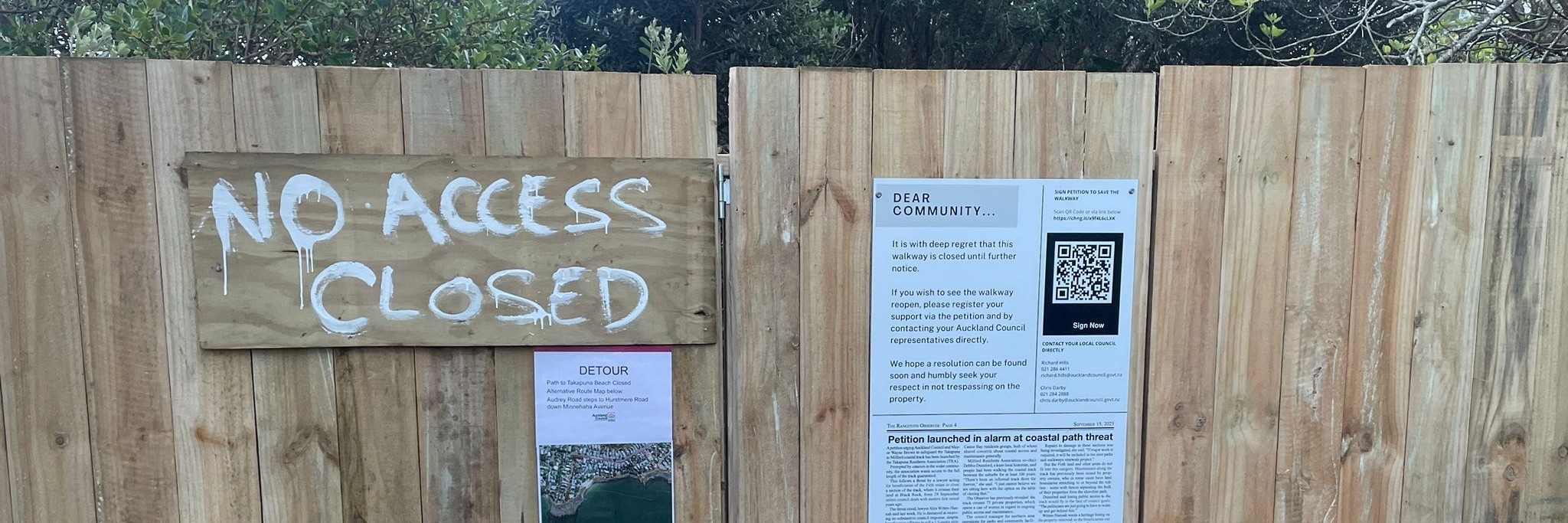Protecting Auckland’s outdoor access in a new environment
The recent loss of access along the Takapuna-Milford path highlights the longstanding legal principle that private land ownership trumps most public interests. In some circumstances, such as easements or rights of way, the public can access private land. But typically, if a landowner does not want you on their land, that is their prerogative.
Weather events have all but washed away the neighbouring Takapuna-Milford beach access. That makes the path more important for Aucklanders. As climate change becomes more severe, this loss of access is a growing problem for our coastal communities. Storms have taken other coastal access from Aucklanders, such as Te Henga Walkway.
The law of the land
The law is not as simple as always supporting private rights over public access. Public access to the outdoors is an important legal principle.
The new Natural and Built Environment Act 2023 emphasises that we should maintain and enhance public access to and along the coastal marine area, lakes and rivers. It also says that we should maintain and enhance public recreational use and enjoyment of the natural environment.
Auckland is scattered with easements, reserves, unformed legal roads and other public access opportunities. These look like private land at a glance but allow people to enjoy the land. Further, many private landowners generously share their special piece of New Zealand by enabling walkways and cycleways.
Legal access is important
Nature, the outdoors, is where we thrive. Physical activities such as walking, running, tramping, biking and mountain biking keep us physically and mentally well. These activities are safer, healthier and easier when people have good outdoor access. Outdoor access is vital for our transport and recreation needs. It connects us to te taiao.
Access to water is an essential part of our cultures. Most coasts and significant lakes and rivers have some public access.
Retreating from climate change
Climate change is moving water boundaries, public and private. Some legal public access will move as our water boundaries move. Some will not and will become impractical to use.
For Aucklanders, climate change is threatening public access to waterways. Kauri dieback is threatening access to forests. And a growing population puts new environmental pressures on access to nature.
As a nation, we are starting to have a conversation about managed retreat. To date, much of that debate has balanced the public safety needs of each community against the economic costs to private landowners. That is an important and nuanced issue for us to work through. But there is a third consideration that we need to include in the debate. We must protect public access rights to the outdoors as Papatūānuku shifts her boundaries on us.
We need to ensure we have continuous legal and practical access to the outdoors, especially waterways.
Good public outdoor access is an important adaptation in the face of climate change. It provides alternative routes of transport when roads close. Natural trails are usually easier and quicker to restore than built roads. They integrate into nature and support the environment. They are often designed, built and maintained by volunteers in local communities.
New access to replace old access
There are some solutions. One example is the proposed Waitakere Foothills Walkway from Swanson to Titirangi. It knits together a mass of small public access to create an extended coherent network. It will need compromises between private and public landowners to become a reality.
Our role at Herenga ā Nuku is to clarify and map what public outdoor access exists and how people can use it. We also have a role advocating to protect and enhance access. For Aucklanders, that means we need a comprehensive network of public outdoor access. We need a network that weaves among private properties, taking us to and across our beaches, hills and forests.

